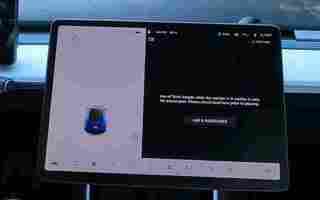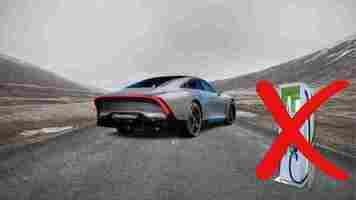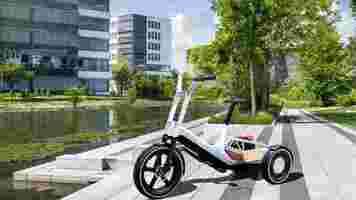Surprise! An investigation into Tesla’s gaming feature made people angry (Update: Tesla gives in)
Surprise, surprise: Tesla‘s under formal investigation by the National Highway Traffic Safety Administration (NTHSA) again.

This time, the NHTSA is investigating the Passenger Play feature. This “allows the gameplay to function on the front center touchscreen while the vehicle is in motion and may present a distraction to the driver,” according to the agency’s official report .
As a result, on Wednesday the Office of Defects Investigation (ODI) opened a Preliminary Evaluation (PE), covering 580,000 Tesla Model 3, S, X, and Y vehicles from 2017 to 2022.
In a summer over-the-air update, Tesla added three new games to its vehicles: Sky Force Reloaded , Solitaire , and The Battle of Polytopia: Moonrise .
When started, the games display a warning message, saying “Use of Tesla Arcade while the vehicle is in motion is only for passengers. Please check local laws prior to playing.”


Once the player presses the “I am passenger” button, the game begins.
In other words, as you long as you indicate that you’re not a passenger, it’s possible to play the three games while the vehicle is in motion, no matter if you’re actually the driver.
You can take a look at the videos below:
In August, the agency received a complaint from a Tesla owner who claimed that l ive games and internet web searching could be used by anyone in the vehicle at any time, asking for action to be taken.
Now the ODI has confirmed that this gameplay functionality has been available since December 2020 in Passenger Play-equipped vehicles. Beforehand, gameplay was enabled only when the vehicle was in Park mode.
The fact that the NHTSA has been triggered by a functionality that can cause driver inattentiveness and potentially a car accident is no surprise.
The agency noted earlier in December that distracted driving accounts for a significant number of road deaths in the US — 3,142 in 2019 alone.
Believe it or not, Tesla has folded. A mere day after the launch of the investigation, the automaker informed the agency that it won’t allow drivers and front-seat passengers to play video games on the dashboard touch screen while its cars are in motion, The Washington Post reports.
Lucia Sanchez, a spokeswoman for the National Highway Traffic Safety Administration, said in an emailed statement:
Having a game occupying two-thirds of your screen (on which you rely for driving information), or, even worse, being able to play it behind the wheel is obviously dangerous.
The NHTSA seems to have taken a necessary precaution, right?
Unsurprisingly, the agency’s move hasn’t been received with unanimous enthusiasm.
On Twitter, many users are expressing their dissatisfaction with NHTSA’s decision, highlighting that phone use or drunk-driving are much more worrisome.
Take a look at the following tweets:
In fact, according to the NHTSA itself, “ texting is the most alarming distraction ” and about 28 people in the US die everyday in drunk-driving crashes .
So are we missing the bigger picture here, focusing on a single tree rather than the forest?
And there’s another point to consider as well: can we blame a company’s tech if we are misusing it?
The answer lies somewhere in the middle.
Yes, the possibility to play games while driving is potentially dangerous and the NHTSA is right to evaluate the frequency of the gameplay’s misuse. Still, a driver should always know better than to indulge to any distraction when behind the wheel — driving is a privilege as much as a responsibility, folks.
Update, December 24, 2021, 1005 CEST: Added information on Tesla’s response to the investigation
Here’s how the Mercedes EQXX concept can boast 1,000km of range
Mercedes’ EQXX concept vehicle is definitely a looker, but what’s really striking about it is its very, very , long range. Specifically, the automaker claims its EV is good for 1,000km on a single charge — that’s enough to take you from Paris to London, for instance. And back.



According to Mercedes , EQXX’s whopping range is the result of efficiency-optimizing innovations, starting with a new proprietary drivetrain that delivers 95% of the battery’s power directly to the wheels.
To further boost the vehicle’s efficiency, the company has also worked on optimizing its aerodynamic design. We can notice an elongated lower body, a small front, and a narrow rear wheel track, all designed to significantly reduce air resistance.
Notably, this design produces a drag coefficient of 0.17, setting a new global record and beating the company’s own EQS model at 0.20. And given that two-thirds of a car’s electric energy are needed just to counter air resistance, bringing the drag coefficient rate as low as possible saves up valuable energy that could give the extra mile.
Despite the vehicle’s long range, Mercedes has opted for a small battery pack, using silicon anodes with ultra-light materials from Formula One. According to the company, “t his enables the battery of the EQXX to store 100 kWh, whilst taking up 50% less space and weighing 30% less than batteries with comparable capacity.”
And here’s an extra ace up the EQXX’s sleeve: the electric system draws additional energy from solar cells on the roof, which can produce up to 25km of extra range.
You can watch the release video explaining the concept’s creation below:
Goddamn, I wish BMW’s cargo ebike concept actually existed
The BMW Group has unveiled its Dynamic Cargo ebike concept, and I simply can’t wait to haul my gear around town on it.

This three-wheeled “pick-up” cargo bike has been developed to offer “increased agility, convenience, and year-round suitability.”


As per BMW, that’s exactly what’s missing from ordinary cargo bikes. They’re usually wider, longer, and heavier than normal bikes, which reduces their driving agility and handling.
I agree completely. Last time I drove such a bike, I found it difficult to maneuver and control it. I’d definitely not consider riding it on a rainy day.
The Dynamic Cargo bike aims to tackle these issues. It comes with a front frame connected to the rear section via a pivot axle, which helps it tilt when cornering and improves overall agility.
At the same time, the rear section remains fixed all the time to ensure stability in all situations and weather conditions.
What I like most about is its very handy storage unit on the rear frame, where you can reportedly fit various modular attachments for carrying luggage and/or children.
BMW also says that the non-pivoting design of the freight platform “has the additional benefit that the rider is barely aware of any extra weight being carried.”
That sounds ideal for someone like me who — okay, I’ll admit it — isn’t very strong and can’t support a big load.
The bike’s electric powertrain gets activated with pedal motion, and offers a range of 20 kilometers. The battery back can be easily removed and recharged at home.
Living in the Netherlands and not owning a car, I can’t begin to tell you how many times I’ve had the issue of how to transport something other than me .
So, if a cargo ebike was available that met the proposed standards above, I’d seriously consider it. Unfortunately, BMW isn’t planning to manufacture the concept bike, but is in discussions with potential licensees — so hopefully some other brand will snatch this idea up soon.
Until then, we’ll have to make do with what we have.
Do EVs excite your electrons? Do ebikes get your wheels spinning? Do self-driving cars get you all charged up?
Then you need the weekly SHIFT newsletter in your life. Click here to sign up .